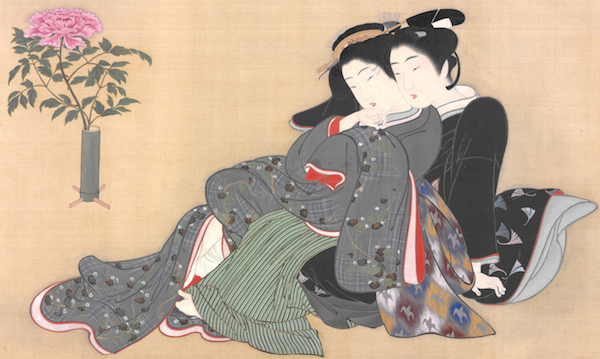It’s difficult to get a window into the world of Edo-Period Japanese prostitutes without the gauzy romantic filter of the male gaze. The artworks in the new San Francisco Asian Art Museum exhibition, “Seduction: Japan’s Floating World,” were made by men for men, the patrons of the Yoshiwara pleasure district outside of Edo, which is now known as Tokyo. Every little detail of Yoshiwara—from the décor and fashion, to the delicacies served at teahouses, to the talents of courtesans, both sexual and intellectual—was engineered to sate a warlord’s every whim.
We’re left with the client-commissioned pretty-girl scroll paintings by masters like Hishikawa Moronobu and Katsukawa Shunshō, as well as woodblock prints and guidebooks by commercial artists meant to lure repeat visitors through the red-light district gates. These often lush and colorful artworks are rife with romantic longing, from the images of interchangeable beauties with inscrutable expressions, to the layers of richly patterned textiles they wore, and the highly symbolic haiku poetry written about them. The showstopper of the exhibition is Moronobu’s nearly 58-foot-long handscroll painting “A Visit to the Yoshiwara,” which takes viewers on a tour of the pleasure district from the street vendors and the food being prepared to the high-ranking courtesans on parade and a couple cuddling under the covers in a teahouse.
The Yoshiwara pleasure district was just part of what the Japanese referred to as “ukiyo” or “the floating world,” which also included the Kabuki theaters of Edo. Originally, the Buddhist term “ukiyo” referred to the sorrow and grief caused by desire, which was seen as an impediment to enlightenment.
“In the Buddhist context, ‘ukiyo’ was written with characters that meant ‘suffering world,’ which is the concept that desire leads to suffering and that’s the root of all the problems in the world,” explains Laura W. Allen, the curator of Japanese art at the Asian Art Museum who originated “Seduction.” “In the 17th century, that term was turned on its head and the term ‘ukiyo’ was written with new characters to mean ‘floating world.’ The concept of the floating world was ignoring the problems that might have existed in a very strictly regulated society and abandoning yourself, bobbing along on the current of pleasure. Then it became associated with two particular sites in Edo, one of which was the Kabuki theater district, the other the Yoshiwara pleasure quarter. The art of the floating worlds ‘ukiyo-e,’ which means ‘floating world pictures,’ usually depicts those two subjects.”
But, of course, by and large, this free-floating sensation belonged to men. Allen suggests that we, as viewers, resist indulging in the fantasies of Yoshiwara prostitutes presented in the artworks, and instead, consider the real lives of the women portrayed. Unfortunately, no true records of the Edo-Period prostitutes’ personal thoughts and experiences exists—and with good reason. Publicizing the dark side of the pleasure district would have been bad for business.
“Don’t take these paintings at face value,” Allen says. “It’s easy to say, ‘Oh, yes, it’s a picture of a beautiful woman, wearing beautiful clothing.’ But it’s not a photograph. It’s some artist’s rendition, made to promote this particular world, which was driven by economics. The profiteers urged the production of more paintings, which continued to feed the frenzy for the Yoshiwara.
“The artwork is very much glamorized and idealized,” she continues. “I haven’t been to 17th-century Japan so I don’t know what it was actually like, and the women didn’t write about it, so we don’t have their firsthand accounts. To imagine it from a woman’s perspective, it must have been a very harsh reality. There’s been some modern scholarship that promotes the idea that the women working as prostitutes had an economic power that they might not have otherwise had. But I think the day-to-day reality of living in the Yoshiwara could not have been pleasant.”
For one thing, most of the women involved didn’t have a choice about their occupation. Born into impoverished farming or fishing villages, they were sold to brothels by desperate parents around the ages of 7 or 8. This tradition was rationalized by Confucian ideals that allowed the children to work out of a duty to their parents, who usually brokered 10-year contracts with the brothel owners that their girls would have to work off. The little girls would do daily chores at the brothels and tended to their “sister” courtesans, cleaning and delivering messages. In those early years, they’d learn the tricks of the trade, how to speak using manipulative language, to write “love letters,” and to fake tears with a bit of alum hidden in their collars.
If a child attendant proved she was gifted by age 11 or 12, she would be chosen for elite courtesan training, where she would learn etiquette and refined arts from masters, including how to play flute or a three-stringed instrument called a samisen, to sing, to paint, to write haiku, to write in calligraphy, to dance, to perform a tea ceremony, and how to play games like go, backgammon, and kickball. She would be well-read and literate in order to engage in stimulating conversation. While these are pleasurable activities and such talents would be a source of pride, these women weren’t encouraged to pursue them for their own fulfillment, but to make themselves more attractive to men.
“They would be trained in the very polite, cultural accomplishments of the type that aristocratic women would have,” Allen says. “The idea was that they were comparable to the wife of a daimyo [feudal lord] or a high-ranking samurai [warrior] in terms of their level of accomplishment. The elite courtesans were supposed to know all of the lady-like skills, and their skill level was keyed to how much space they would have in a brothel and how lavish their clothing was. It was a very carefully calibrated hierarchy.”
by Lisa Hix, Collector's Weekly | Read more:
Image: Katsukawa Shunshō, Secret Games in the Spring Palace